Concentrated solar thermal power could replace nuclear reactors
Catastrophic nuclear accidents are just about impossible, we need not worry about them. That is what the nuclear experts and the lobby for nuclear power production are telling us. Yet, an earthquake and a tsunami in Japan, and the subsequent loss of control over nuclear reactors at the Fukushima power plant teach us a different lesson. What is happening there reminds us that "impossible" is not something we can really put any stock in.
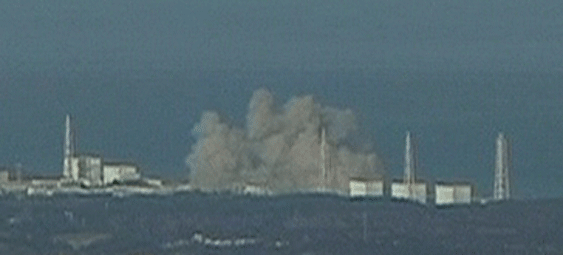
An explosion destroys reactor number 1 at Fukushima nuclear power plant
The nuclear catastrophe following a destructive earthquake and tsunami at Japan's eastern coast is still unfolding. No one knows yet what the ultimate consequences will be for the people of Japan and the world. What we do know is that nuclear power production is based on a highly unstable reaction that must be actively controlled if the fuel is not to overheat and blow up in our face.
People are getting uneasy about the 'nuclear option', promoted as the needed replacement for carbon, oil and gas based energy, as global warming takes its toll. Leaving aside for the moment the discussion on climate change and anthropogenic global warming, which is far from resolved, I do agree that we need to change our energy policy. Not because of CO2 but because we pollute the environment, making it inhospitable to humans and other life, by continuing on our current course. Coal, oil and nuclear are not options for the future.
Yet in discussions about the necessity of changing over to a different mode of energy production, we are told that renewables could never replace conventional energy, and that the only choice is between coal/oil and nuclear power plants.
That is a rather bald-faced lie. The fact is that by concentrating the sun's rays, great quantities of high grade thermal energy can be obtained, sufficient to run the industrial machines needed to uphold present levels of civilization. We can produce steel and aluminium with the electricity a concentrated solar thermal plant supplies. The steam turbines and generators that are today being run by coal and gas or by nuclear can just as well be driven by ... the sun's rays.
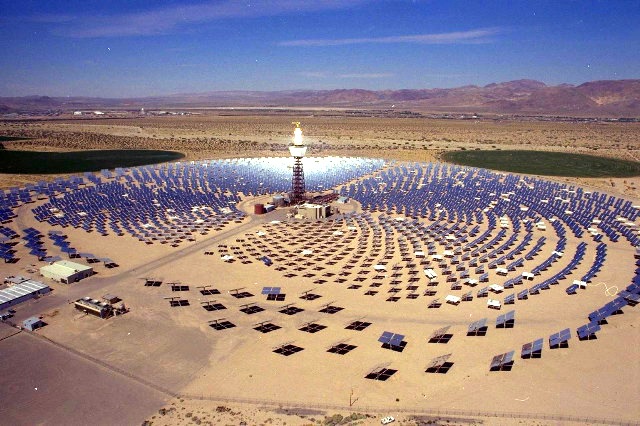
Mirrors concentrate the sun's rays and direct them on a heat exchanger located on a central tower
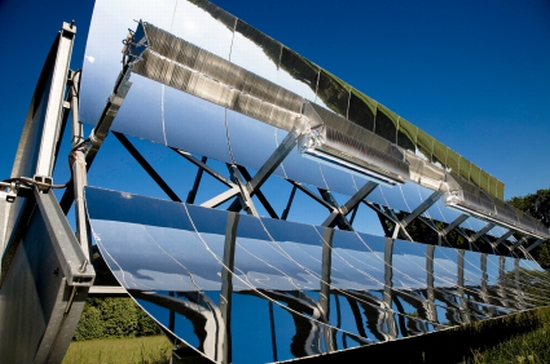
Long troughs of parabolic mirrors with a heat exchanger at their focal point are another way of harvesting the sun's heat
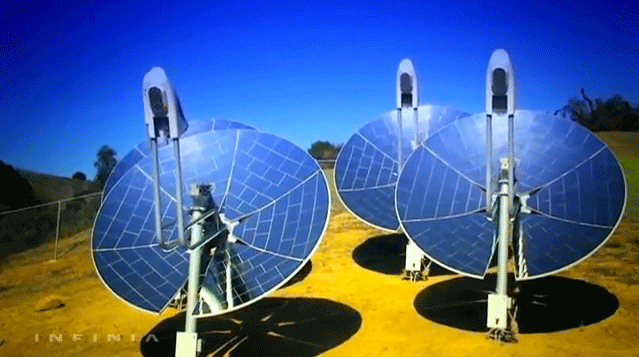
Mirrors can also take the form of a "satellite dish" and concentrate the sun's rays on a generator driven by a stirling motor
- - -
The most important thing about the sun's energy is its abundance. In just six hours, more energy from the sun reaches the Earth's deserts than is consumed by all of humanity in an entire year. Consequently, it would take a relatively small area of desert land to produce all the electric power the world consumes.
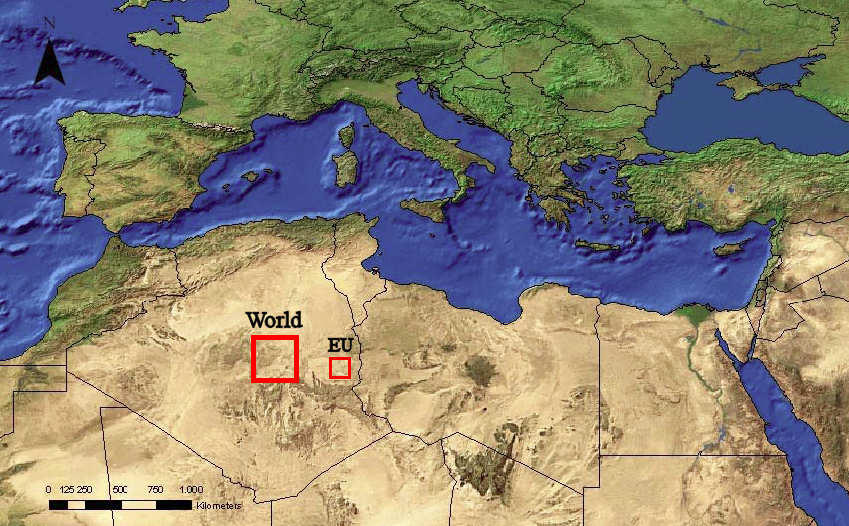
This map shows how much land would need to be covered by concentrating solar power plants to produce all of the electricity currently used in Europe (the small red square) and in the whole world (the larger red square)
The illustration was part of a report on a German-inspired proposal to produce Europe's electricity in the North African Sahara desert using concentrating solar power plants. Going to the desert for solar power would require additional investment in new electric transmission lines to bring the electricity where it is needed, but there is nothing impossible about it. We can subsidize nuclear power plants with tax payers' funds, so we could certainly subsidize a clean energy alternative.
The proposed concept lives under the name of Desertec:
The key technologies are available, proven and field-testedDeserts span the Earth north and south of the equator. With the help of High Voltage Direct Current transmission lines, clean solar and wind energy can be transmitted over thousands of kilometers to the consumption centers of the world. Transmission losses amount to only three percent per 1,000 km and slight additional costs of about 1-2 cent per kilowatt-hour, compared to the significantly higher efficiency of the solar-thermal power plants coming from the higher and longer insolation.
Concentrating solar thermal power (CSP) plants offer a noticeable advantage when compared to photovoltaics: Different to electricity, large amounts of thermal energy can be stored easily with minimal losses, thus they can provide energy on demand - day and night. In this manner, CSP plants are capable of both reliably producing large quantities of power and, if they are part of a network with other renewable energies, compensating fluctuations of wind and photovoltaic energy.
The Desertec proposal is specific for Europe. The U.S. could easily adapt this concept and produce all the energy it needs in their own deserts of the American southwest. And while deserts are a natural choice for this kind of solar energy, it is by no means limited to the hot, dry and sandy areas. Nor are we limited to megawatt-sized power plants. Farms could have their own solar power plants, and where space is a consideration, solar panels for direct photovoltaic conversion of the sun's light into electricity could cover every roof.
Other reports and collections of information:
Concentrating Solar Power Now - Clean energy for sustainable development
(published by the German Center for Aviation and Space - DLR)
Poor Richard's Almanack - What is solar power?
Concentrated solar power on PESWiki
Concentrated solar power on Wikipedia
The Concentrated Solar Power Open Source Initiative
Solar thermal collection system uses Sun's heat to keeps things cool
and about solar photovoltaic:
Germany's solar panels produce more power than Japan's entire Fukushima complex
GERMANY SET TO ABANDON NUCLEAR POWER FOR GOOD
Energy: Cost of Solar Power Competitive with Coal Some Places, & Dropping Fast
"Large photovoltaic projects will cost $1.45 a watt to build by 2020, half the current price," Bloomberg New Energy Finance reported. However, already, in sunny regions like the Middle East and California, "solar is viable against fossil fuels on the electric grid."
"We are already in this phase change and are very close to grid parity," Shawn Qu, chief executive officer of Canadian Solar Inc. (CSIQ), said. "In many markets, solar is already competitive with peak electricity prices, such as in California and Japan."
Open source concentrating solar thermal in India:
Solar Fire is the use of direct solar thermal energy to replace conventional fires of wood and coal at the domestic, agricultural and industrial level. The project is open source.
Video: Solar Fire P32 - Part 1 - Basics
And a rather large solar project now under construction, showing this can really replace older technologies:
World's Largest Solar Plant in Blythe, California Approved for Construction
Construction of a 1000 MW solar plant in Blythe, California finally received approval yesterday by the U.S. government. The plant, to be built in the Mojave Desert, is currently the largest solar plant to begin construction and will generate electricity to power 300,000 homes, more than doubling the amount of solar power currently produced in the United States.
The 7000 acre solar plant will be developed by Solar Millenium and will create 1066 jobs during construction and 295 permanent jobs when operational. Construction is expected to begin at the end of 2010 and to produce electricity by 2013. The project is estimated to cost $6 billion.
The solar plant will use a parabolic trough system, a form of concentrating solar power (CSP), "whereby parabolic mirrors focus the sun's energy onto collector tubes. Fluid in the tubes is then heated and sent to a boiler, which sends live steam to a turbine to produce electricity."
The biggest hurdle to widespread implementation of solar power is the fact that the sun doesn't shine constantly in any given place, so backup power systems are needed for nights and cloudy days. But a novel system designed by researchers at MIT could finally overcome that problem, delivering steady power 24/7.
The plan, detailed in a paper published in the journal Solar Energy, would use an array of mirrors spread across a hillside, aimed to focus sunlight on the top of the tank of salt below. The system could be "cheap, with a minimum number of parts," says Slocum, the Pappalardo Professor of Mechanical Engineering at MIT and lead author of the paper. Reflecting the system's 24/7 power capability, it is called CSPonD (for Concentrated Solar Power on Demand).
The new system could also be more durable than existing CSP systems whose heat-absorbing receivers cool down at night or on cloudy days. "It's the swings in temperature that cause [metal] fatigue and failure," Slocum says. The traditional way to address temperature swings, he says: "You have to way oversize" the system's components. "That adds cost and reduces efficiency."
Who needs oil? World's largest solar power plant with 258,000 mirrors opens in Abu Dhabi
You might think that as one of the world's top oil producing nations, the United Arab Emirates would have little use for solar energy.
But that hasn't stopped the Middle East state from unveiling the largest concentrated solar power plant in operation anywhere in the world.
The 100-megawatt solar-thermal project in Abu Dhabi will power thousands of homes in the country and, it is hoped, displace approximately 175,000 tons of CO2 per year.
Comments
March 24, 2011 12:11 PM | Posted by: Prem das
We are in this predicament because the cold war between America and Russia determined the kind of reactors that were chosen.
America had a safer option in the Thoriam reactors but the arms industry needed the plutonium the wrong kind of reactors produced.
Let us go back to Thoriam again even though the patent has been sold to the Danes.
Let's face facts no other technology can replace nuclear's convienience and reliability with minimal pollution.
March 24, 2011 1:06 PM | Posted by: Sepp
Thorium may be safer than uranium, but it is by no means the only option available.
The sun's economics beat nuclear at every turn, and don't let me start in on pollution... there never was "clean" atomic power.
Why do governments have to hold the nuclear industry's hand and help find (and pay for) a place to store all the radioactive garbage that remains when those "clean" reactors are de-commissioned?
March 24, 2011 5:03 PM | Posted by: Gilles
For your information: The Quasiturbine Steam engine is an uniflow positive displacement rotary design particularly suitable for direct drive solar steam system.
March 24, 2011 5:36 PM | Posted by: David G. Yurth
Solar power and wind power both suffer from the same shortcoming - no one has yet developed a commercially viable means of storing collected energy for use when the sun is not shining and the wind is not blowing. We have solved this problem. We are working with partners in South America and Australia to build and deploy a prototype of an integrated solution that stores the wind and the sun's energy for delivery on demand 24/7. This solution renders nuclear power obsolete. Rock on!
March 25, 2011 2:55 PM | Posted by: Sepp
@ Gilles - is your quasiturbine commercially available to anyone who would like to try it out as part of a small scale concentrated solar power facility?
@ David - about that integrated solution: can you explain in a few words what that solution is, or provide a link where readers can find out? That would be awesome.
March 27, 2011 6:18 AM | Posted by: Gilles
@ Gilles - is your Quasiturbine commercially available to anyone who would like to try it out as part of a small scale concentrated solar power facility?
Yes. Actually we currently manufacture QT in 1.5 and 12 kW units under steam from 0 to 60 psi running at 500 rpm. Details are given on http://www.quasiturbine.com
In addition, the pneumatic QT units present interest for compressed air energy storage, and as an expander for natural gas pipeline pressure energy recovery.
March 27, 2011 9:02 PM | Posted by: shintashi
I've been promoting the concentrated solar reactors for a few weeks now, since the premise of a nuclear reactor is nothing more than a glorified water heater, and an array of mirrors can produce scalable temperatures matching reactor levels, without the radioactive isotopes.